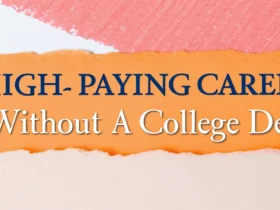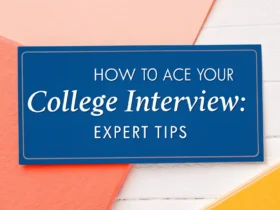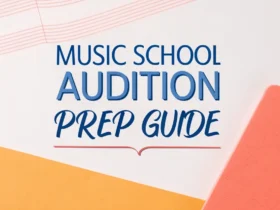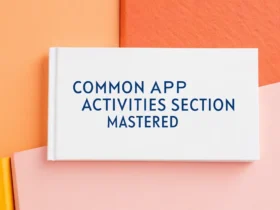Crafting a compelling art school portfolio can feel like scaling a mountain. The pressure to showcase your best work, demonstrate your artistic vision, and stand out from a sea of talented applicants can be overwhelming. Are you ready to learn more about art admission?
It is estimated that less than half the students who apply to art schools get in. But there’s no reason you can’t be one of them.
This guide is designed to be your compass and map, leading you through the often-intricate process of preparing an art school portfolio that will impress art admission committees. We will walk you through each critical step, providing insights, tips, and examples.
Art School Portfolio: What Is It and Why Does It Matter?
An art school portfolio is a curated collection of your artwork that you submit as part of your application to art school or a university art program. It’s more than just a collection of pretty pictures; it is a visual representation of your artistic skills, creativity, and potential. The portfolio allows art admission committees to assess your abilities, understand your artistic interests, and determine if you are a good fit for their program.
The importance of your art school portfolio cannot be overstated. It often carries more weight than academic transcripts or standardized test scores. Why? Because it provides tangible evidence of your artistic talent and dedication. Here’s a deeper look at why your portfolio matters:
- Demonstrates Your Skills: A well-crafted portfolio showcases your technical abilities in various mediums, such as drawing, painting, sculpture, photography, or digital art. It proves you possess the foundational skills necessary for success in an art program.
- Highlights Your Creativity and Vision: Your portfolio is an opportunity to express your unique artistic voice and vision. It demonstrates your ability to think critically, experiment with different ideas, and develop a personal style.
- Reflects Your Passion and Commitment: The time and effort you invest in your portfolio speak volumes about your passion for art and your commitment to honing your craft.
- Differentiates You from Other Applicants: In a competitive applicant pool, a strong portfolio can set you apart from other talented individuals. It’s your chance to showcase your individuality and make a lasting impression on the art admission committee.
- Opens Doors to Scholarships and Opportunities: A standout portfolio can increase your chances of receiving scholarships and other financial aid opportunities. It also opens doors to internships, exhibitions, and other career-enhancing experiences.
In essence, your art school portfolio is your artistic resume. It tells a story about who you are as an artist and what you hope to achieve. With careful planning, diligent execution, and a touch of creativity, you can create a portfolio that will open doors to your dream art school.
Understand Art Admission Requirements
Before you even begin assembling your portfolio, it’s essential to understand the specific art admission requirements of the schools you’re applying to. Each art school has its own unique criteria and expectations. Failing to meet these requirements can significantly diminish your chances of acceptance, no matter how strong your artwork may be.
Here’s a step-by-step guide to understanding and meeting art admission requirements:
-
Research Each School’s Website: The official website of each art school is your first and best source of information. Look for dedicated admissions pages that outline the portfolio requirements in detail. Pay close attention to:
- Portfolio Size and Format: How many pieces should your portfolio include? Should it be submitted digitally or as physical artwork? Are there specific size or resolution requirements for digital images?
- Medium and Subject Matter: Are there any restrictions on the mediums you can use? Are there specific subject matter requirements or recommendations?
- Specific Prompts or Assignments: Some art schools require applicants to complete specific assignments or prompts as part of their portfolio. These assignments are designed to assess your problem-solving skills, creativity, and ability to follow instructions.
- Statement of Intent: Many art schools require a written statement of intent or artist statement. This statement allows you to articulate your artistic goals, explain your creative process, and discuss the themes and ideas that inspire your work.
- Deadlines: Be sure to note the application deadlines and portfolio submission dates. Missing a deadline can automatically disqualify you from consideration.
-
Attend Virtual or In-Person Information Sessions: Many art schools host virtual or in-person information sessions for prospective students. These sessions provide valuable insights into the art admission process and offer an opportunity to ask questions directly to admissions staff and faculty.
- Contact the Admissions Office: If you have any questions about the art admission requirements that are not answered on the school’s website or during an information session, don’t hesitate to contact the admissions office directly. Admissions officers are there to assist you and provide clarification.
- Review Sample Portfolios: Some art schools provide sample portfolios from successful applicants on their websites. Reviewing these samples can give you a better understanding of the type of artwork and skill level they are looking for. However, avoid simply copying the style or content of these portfolios. Use them as inspiration but strive to create a portfolio that is unique and reflects your own artistic voice.
-
Understand the Evaluation Criteria: Art schools typically evaluate portfolios based on a variety of criteria, including:
- Technical Skill: Your ability to demonstrate proficiency in various art techniques and mediums.
- Creativity and Originality: Your ability to generate unique ideas and express them in innovative ways.
- Conceptual Strength: Your ability to develop and communicate meaningful concepts through your artwork.
- Composition and Design: Your ability to create visually compelling compositions and utilize the elements of design effectively.
- Presentation: The overall quality and professionalism of your portfolio presentation.
- Growth Potential: Your demonstrated potential to grow and develop as an artist.
By carefully researching and understanding the specific art admission requirements of each school, you can tailor your portfolio to meet their expectations and increase your chances of acceptance.
Assemble Your Best Work
The core of your art school portfolio is the artwork itself. It’s crucial to select pieces that showcase your strengths, demonstrate your range, and reflect your artistic interests. This is not the time to include every piece you’ve ever created. Be selective and prioritize quality over quantity.
Here’s a guide to assembling your best work:
- Review Your Entire Body of Work: Start by gathering all of your artwork from the past few years. This includes drawings, paintings, sculptures, photographs, digital art, and any other creative projects you’ve undertaken.
- Identify Your Strengths: As you review your work, identify the pieces that you are most proud of and that you believe best represent your artistic abilities. Consider the technical skill, creativity, and conceptual strength of each piece.
- Showcase a Range of Skills and Mediums: Art schools want to see that you are versatile and capable of working in different mediums. Include pieces that demonstrate your proficiency in drawing, painting, sculpture, photography, and digital art, if applicable. If you excel in a particular medium, such as painting, include a few pieces that highlight your expertise.
- Include Observational Drawings: Observational drawings, also known as “from life” drawings, are an essential component of most art school portfolios. These drawings demonstrate your ability to accurately observe and represent the world around you. Include drawings of still life, landscapes, portraits, and figures.
- Incorporate Personal Projects: While it’s important to demonstrate technical skill, art schools also want to see your unique artistic voice and vision. Include personal projects that reflect your interests, passions, and perspectives. These projects can be more experimental and conceptual in nature.
- Prioritize Recent Work: Art schools are most interested in your current abilities and potential. Prioritize including your most recent work, as it best reflects your current skill level and artistic development.
-
Be Critical and Self-Reflective: It’s essential to be critical and self-reflective when selecting pieces for your portfolio. Ask yourself:
- Does this piece showcase my strengths?
- Does this piece demonstrate my creativity and originality?
- Does this piece effectively communicate my ideas?
- Is this piece technically well-executed?
- Is this piece representative of my artistic interests?
If you can’t answer “yes” to all of these questions, consider removing the piece from your portfolio.
8. Seek Feedback from Teachers, Mentors, and Peers: Before finalizing your portfolio, seek feedback from trusted teachers, mentors, and peers. They can provide valuable insights and help you identify areas for improvement. Be open to constructive criticism and use it to refine your portfolio.
9. Choose a Cohesive Theme or Narrative: While it’s important to showcase a range of skills and mediums, it’s also helpful to choose a cohesive theme or narrative for your portfolio. This can help create a sense of unity and purpose and demonstrate your ability to develop a focused body of work. The theme could be a recurring subject matter, a particular style or technique, or a conceptual thread that connects your pieces.
By carefully selecting your best work, showcasing your range, and prioritizing quality over quantity, you can create a portfolio that will impress art admission committees and demonstrate your potential for success.
Showcase Your Process
Art schools are not only interested in the final product, but also in the creative process behind your artwork. Showcasing your process allows the art admission committee to understand how you think, how you experiment, and how you develop your ideas. It demonstrates your problem-solving skills, your willingness to take risks, and your ability to learn from your mistakes.
Here are some ways to showcase your process in your art school portfolio:
-
Include Sketchbooks and Preliminary Drawings: Sketchbooks and preliminary drawings provide valuable insights into your creative process. They show how you explore ideas, experiment with different compositions, and develop your skills. Include pages from your sketchbooks that demonstrate your thought process, such as:
- Thumbnail sketches
- Compositional studies
- Color palettes
- Notes and annotations
- Experiments with different techniques
-
Document Your Work in Progress: Take photographs or videos of your artwork as it progresses. This allows the art admission committee to see how your ideas evolve and how you overcome challenges.
-
Include Process-Oriented Projects: Consider including projects that are specifically designed to showcase your process. These projects could involve:
- A series of studies exploring different variations of a single subject
- A project documenting the development of a single idea from concept to completion
- A collaborative project demonstrating your ability to work with others
-
Write Detailed Captions and Artist Statements: Use captions and artist statements to explain your process and provide context for your work. Discuss:
- The inspiration behind your ideas
- The challenges you faced and how you overcame them
- The materials and techniques you used
- The conceptual underpinnings of your work
- The lessons you learned from the process
-
Create a Digital Presentation: If you are submitting your portfolio digitally, consider creating a presentation that incorporates images of your artwork, sketchbook pages, process documentation, and artist statements. This presentation can provide a more comprehensive overview of your creative process.
- Be Authentic and Honest: When showcasing your process, be authentic and honest. Don’t try to present a perfect or idealized version of your creative journey. Show the struggles, the setbacks, and the moments of discovery that make your process unique.
By showcasing your process, you can demonstrate your commitment to learning, your ability to think critically, and your passion for artistic exploration. This will make your portfolio more engaging, informative, and memorable.
Presentation Matters
The presentation of your art school portfolio is just as important as the artwork itself. A well-presented portfolio demonstrates your attention to detail, your professionalism, and your respect for your work. A sloppy or disorganized presentation can detract from even the strongest artwork.
Here are some tips for presenting your art school portfolio effectively:
-
Choose the Right Format: The format of your portfolio will depend on the specific art admission requirements of the schools you’re applying to. Some schools require digital submissions, while others prefer physical portfolios. If you have the option, consider the advantages and disadvantages of each format:
- Digital Portfolios: Digital portfolios are convenient, easy to share, and allow you to incorporate multimedia elements such as videos and animations. They are also more environmentally friendly and less expensive to produce than physical portfolios.
- Physical Portfolios: Physical portfolios provide a more tactile and immersive experience for the viewer. They allow you to showcase the actual textures and dimensions of your artwork. They also demonstrate your craftsmanship and attention to detail.
-
Organize Your Work Logically: Arrange your artwork in a logical and visually appealing order. Consider the following organizational strategies:
- Chronological Order: Present your work in chronological order to demonstrate your artistic growth and development over time.
- Thematic Order: Group your work by theme or subject matter to create a cohesive narrative.
- Medium-Based Order: Organize your work by medium, such as drawing, painting, sculpture, or photography.
- Strengths-Based Order: Start with your strongest pieces to make a positive first impression and end with a strong piece to leave a lasting impression.
-
Use High-Quality Images: If you are submitting your portfolio digitally, use high-quality images that accurately represent your artwork. Ensure that your images are well-lit, properly cropped, and free from distractions. Consider hiring a professional photographer to photograph your artwork, especially if you are applying to highly competitive programs.
- Pay Attention to Design and Layout: The design and layout of your portfolio can significantly impact its overall presentation. Use a clean and consistent design aesthetic that complements your artwork. Avoid clutter and distractions. Use white space effectively to create a sense of visual balance and harmony.
- Craft Concise Captions and Artist Statements: Write clear and concise captions and artist statements that provide context for your artwork. Discuss the title, medium, dimensions, and conceptual underpinnings of each piece. Proofread your captions and statements carefully for spelling and grammar errors.
- Choose a Professional Portfolio Case or Website Template: If you are submitting a physical portfolio, choose a professional portfolio case that is durable, lightweight, and easy to carry. If you are submitting a digital portfolio, choose a website template that is clean, modern, and easy to navigate.
- Seek Feedback on Your Presentation: Before finalizing your portfolio presentation, seek feedback from teachers, mentors, and peers. Ask them to review your organization, design, and captions and provide suggestions for improvement.
- Practice Your Presentation: If you are invited to present your portfolio in person, practice your presentation beforehand. Be prepared to discuss your artwork, your process, and your artistic goals.
By paying attention to the presentation of your art school portfolio, you can ensure that your artwork is showcased in the best possible light and that you make a positive and lasting impression on the art admission committee.
Tailor Your Portfolio
While it’s important to showcase your artistic strengths and range, it’s equally important to tailor your portfolio to the specific programs and schools you’re applying to. Each art school has its own unique focus, philosophy, and curriculum. Submitting a generic portfolio that doesn’t align with the school’s values can diminish your chances of acceptance.
Here’s a guide to tailoring your portfolio:
-
Research the School’s Programs and Faculty: Before you begin tailoring your portfolio, thoroughly research the programs and faculty at each school you’re applying to. Pay attention to:
- Program Focus: What are the specific areas of emphasis within each program? Does the school specialize in painting, sculpture, photography, digital art, or a combination of disciplines?
- Faculty Interests: What are the research interests and artistic styles of the faculty members? Are there any faculty members whose work resonates with your own artistic interests?
- School Philosophy: What is the overall philosophy and approach to art education at the school? Is the school more traditional or experimental in its approach?
-
Select Work That Aligns with the School’s Focus: Choose artwork that aligns with the school’s specific programs and faculty interests. For example, if you are applying to a school with a strong emphasis on painting, include a greater number of paintings in your portfolio. If you are applying to a school with a focus on conceptual art, include more process-oriented and experimental projects.
- Highlight Relevant Skills and Experiences: Emphasize the skills and experiences that are most relevant to the program you’re applying to. For example, if you are applying to a graphic design program, highlight your skills in typography, layout, and visual communication. If you are applying to an animation program, showcase your skills in character design, storyboarding, and motion graphics.
- Address Specific Prompts or Assignments: If the art school requires specific prompts or assignments as part of the portfolio, be sure to address them directly and thoughtfully. These assignments are designed to assess your problem-solving skills, creativity, and ability to follow instructions.
- Write Tailored Artist Statements: Customize your artist statements to reflect your understanding of the school’s programs, faculty, and philosophy. Discuss how your artistic goals align with the school’s mission and how you believe the school can help you achieve your aspirations.
- Demonstrate Your Interest in the School’s Community: Show that you have taken the time to learn about the school’s community and culture. Mention specific faculty members, programs, or initiatives that you find particularly appealing. Attend virtual or in-person events and engage with current students and alumni.
- Seek Feedback from Alumni or Current Students: If possible, seek feedback on your portfolio from alumni or current students of the schools you’re applying to. They can provide valuable insights into the school’s culture and expectations and help you tailor your portfolio accordingly.
By tailoring your portfolio to the specific programs and schools you’re applying to, you can demonstrate your genuine interest in the school and increase your chances of acceptance.
Write a Compelling Artist Statement
The artist statement is a written piece that accompanies your art school portfolio, providing context for your work and articulating your artistic vision. It is an opportunity to communicate your ideas, explain your creative process, and discuss the themes and concepts that inspire your work. A well-written artist statement can significantly enhance your portfolio and demonstrate your ability to think critically and communicate effectively.
Here’s a guide to writing a compelling artist statement:
- Start with an Introduction: Begin your statement with a brief introduction that provides an overview of your artistic practice. Discuss your primary mediums, themes, and concepts.
- Explain Your Inspiration: Discuss the sources of inspiration for your work. What artists, movements, or ideas influence your creative process? Are there any personal experiences or observations that have shaped your artistic vision?
- Describe Your Creative Process: Explain your creative process in detail. How do you develop your ideas? What materials and techniques do you use? How do you overcome challenges and experiment with new approaches?
- Discuss the Themes and Concepts: Discuss the underlying themes and concepts that inform your work. What are you trying to communicate through your artwork? What questions are you exploring? What emotions are you trying to evoke?
- Connect Your Work to the World: Explain how your work relates to broader social, cultural, or political issues. How does your artwork engage with the world around you? What impact do you hope to have on your audience?
- Be Authentic and Personal: Write in your own voice and be authentic and personal in your expression. Avoid using overly academic or pretentious language. Let your personality shine through.
- Keep It Concise and Focused: Aim for a statement that is concise and focused. Avoid rambling or including irrelevant information. Focus on the most important aspects of your artistic practice.
- Tailor Your Statement to Each School: Customize your artist statement to reflect your understanding of the specific programs, faculty, and philosophy of each school you’re applying to. Discuss how your artistic goals align with the school’s mission and how you believe the school can help you achieve your aspirations.
- Proofread Carefully: Proofread your statement carefully for spelling and grammar errors. Ask a teacher, mentor, or peer to review your statement and provide feedback.
- Avoid Clichés and Generalities: Stay away from using clichés and generic terms.
A compelling artist statement should provide insight into the artist’s mind and the heart behind their art.
Common Portfolio Mistakes to Avoid
Preparing an art school portfolio is a challenging process, and it’s easy to make mistakes along the way. However, by being aware of common portfolio pitfalls, you can avoid these errors and increase your chances of acceptance.
Here are some common portfolio mistakes to avoid:
- Including Too Much Work: It’s better to include a smaller number of high-quality pieces than a large number of mediocre ones. Art schools are looking for your best work, not a comprehensive inventory of everything you’ve ever created.
- Including Work That Doesn’t Showcase Your Strengths: Focus on showcasing the pieces that best demonstrate your technical skills, creativity, and conceptual strength. Avoid including work that is weak or doesn’t reflect your artistic interests.
- Failing to Meet the Specific Art Admission Requirements: Each art school has its own unique requirements for portfolio size, format, and content. Failing to meet these requirements can automatically disqualify you from consideration.
- Presenting Your Work Poorly: A sloppy or disorganized presentation can detract from even the strongest artwork. Pay attention to the design and layout of your portfolio, and ensure that your images are high-quality and well-lit.
- Not Showcasing Your Process: Art schools want to see not only your finished artwork but also the creative process behind it. Include sketchbook pages, preliminary drawings, and process documentation to demonstrate your problem-solving skills and your ability to experiment.
- Writing a Weak Artist Statement: The artist statement is an opportunity to communicate your ideas, explain your creative process, and discuss the themes and concepts that inspire your work. A poorly written artist statement can diminish the impact of your portfolio.
- Copying Other Artists’ Styles: Art schools are looking for originality and individuality. Avoid simply copying the style or content of other artists’ work. Develop your own unique artistic voice and vision.
- Not Seeking Feedback: Before finalizing your portfolio, seek feedback from teachers, mentors, and peers. They can provide valuable insights and help you identify areas for improvement.
- Procrastinating: Preparing an art school portfolio takes time and effort. Don’t wait until the last minute to start working on your portfolio. Give yourself ample time to create strong artwork, assemble your portfolio, and seek feedback.
- Not Proofreading: The content in the portfolio must be easy to understand and grammatically correct. Proofread all your work before submitting.
By avoiding these common portfolio mistakes, you can create a compelling and professional portfolio that will impress art admission committees and increase your chances of acceptance.
Is Art School the Right Path for You?
As you prepare your art school portfolio, it’s also important to reflect on whether art school is the right path for you. While art school can provide valuable training, mentorship, and networking opportunities, it’s not the only path to a successful career in the arts.
Here are some questions to consider as you evaluate your options:
- What Are Your Career Goals? What do you hope to achieve with your art education? Do you want to become a professional artist, designer, illustrator, or animator? Are you interested in teaching art or working in a museum or gallery?
- What Are Your Learning Style and Preferences? Do you thrive in a structured academic environment, or do you prefer a more self-directed approach to learning? Are you comfortable with critiques and feedback, or do you prefer to work independently?
- What Are Your Financial Resources? Art school can be expensive. Can you afford tuition, fees, and living expenses? Are you willing to take out student loans? Are there scholarship opportunities available?
- Are There Alternative Paths to Achieving Your Goals? Are there other ways to gain the skills and experience you need to pursue your career goals? Can you learn from online courses, workshops, or apprenticeships? Can you build your portfolio independently?
-
What Are the Pros and Cons of Art School? Consider the advantages and disadvantages of attending art school:
-
Pros:
- Structured curriculum and training
- Mentorship from experienced faculty
- Networking opportunities with peers and industry professionals
- Access to specialized equipment and facilities
-
Credentials that may be valued by employers
- Cons:
-
High tuition costs and student loan debt
- Competitive environment
- Pressure to conform to certain artistic styles or trends
- Limited career opportunities in some fields
- Potential for disillusionment or burnout
-
-
Explore Alternative Options: If you’re not sure whether art school is the right path for you, consider exploring alternative options:
- Online Art Courses: There are many high-quality online art courses available that can provide you with the skills and knowledge you need to pursue your artistic interests.
- Workshops and Residencies: Workshops and residencies offer intensive learning experiences in a specific art discipline. They can be a great way to hone your skills and network with other artists.
- Apprenticeships: Apprenticeships provide hands-on training under the guidance of an experienced artist or designer. They can be a valuable way to learn practical skills and gain real-world experience.
- Independent Study: You can also pursue your artistic goals through independent study. Set your own learning goals, create your own curriculum, and build your portfolio independently.
By carefully considering your career goals, learning style, financial resources, and alternative options, you can make an informed decision about whether art school is the right path for you.
Should You Get In?
Preparing an art school portfolio is a significant undertaking. It calls for time, effort, and dedication. By understanding the art admission requirements, assembling your best work, showcasing your process, presenting your portfolio effectively, tailoring your work to each school, and writing a compelling artist statement, you can create a portfolio that will impress art admission committees and increase your chances of acceptance.
But remember, even with a standout portfolio, art school may not be for everyone. Be sure to reflect on your career goals, learning style, and financial resources. Consider alternative paths to achieving your artistic aspirations. If you are honest with yourself and carefully weigh your options, you can make the decision that is best for you.















Leave a Reply
View Comments